Community Health Nurse's Role and Disaster Management Strategies
VerifiedAdded on 2022/08/26
|11
|1217
|20
Report
AI Summary
This report examines the crucial role of community health nurses in disaster management, focusing on the stages of preparedness, response, and recovery. It defines a disaster, categorizing it into natural and man-made events, with hurricanes as a specific example. The report details the levels of prevention, from primary to tertiary, and outlines the stages of disaster management: assessment, preparedness, response, recovery, mitigation, and impact. It emphasizes the responsibilities of community health nurses, including assessing environmental health hazards, educating the public, maintaining a safe environment, and encouraging community participation. The report also identifies key agencies involved in disaster management, such as the Environmental Protection Agency (EPA), Federal Emergency Management Agency (FEMA), Federal Bureau of Investigation (FBI), and the American Red Cross (ARC), detailing their respective roles and contributions to disaster relief and management. The report underscores the importance of proactive planning and collaborative efforts in mitigating the impact of disasters and supporting community resilience.
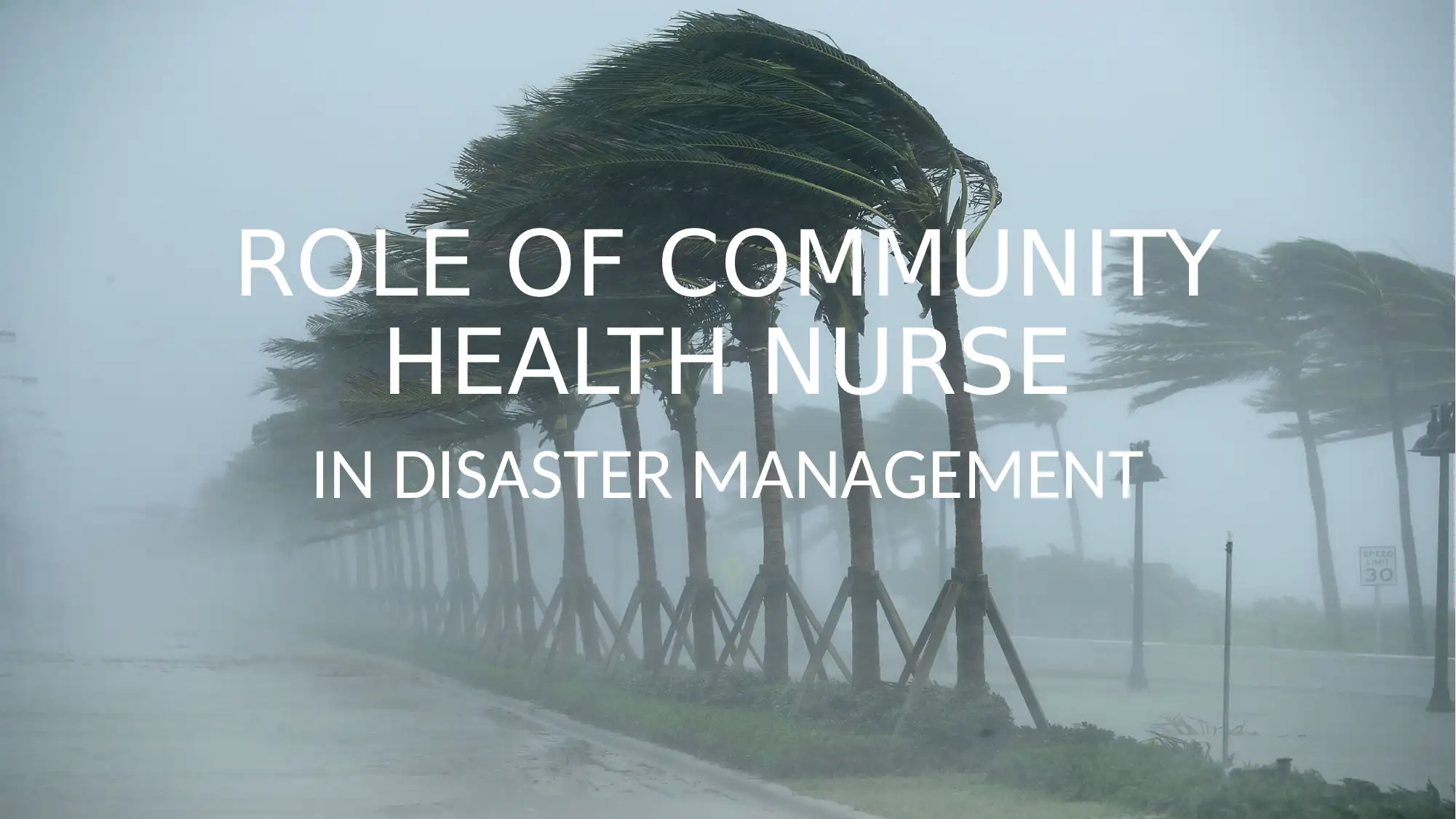
ROLE OF COMMUNITY
HEALTH NURSE
IN DISASTER MANAGEMENT
HEALTH NURSE
IN DISASTER MANAGEMENT
Paraphrase This Document
Need a fresh take? Get an instant paraphrase of this document with our AI Paraphraser
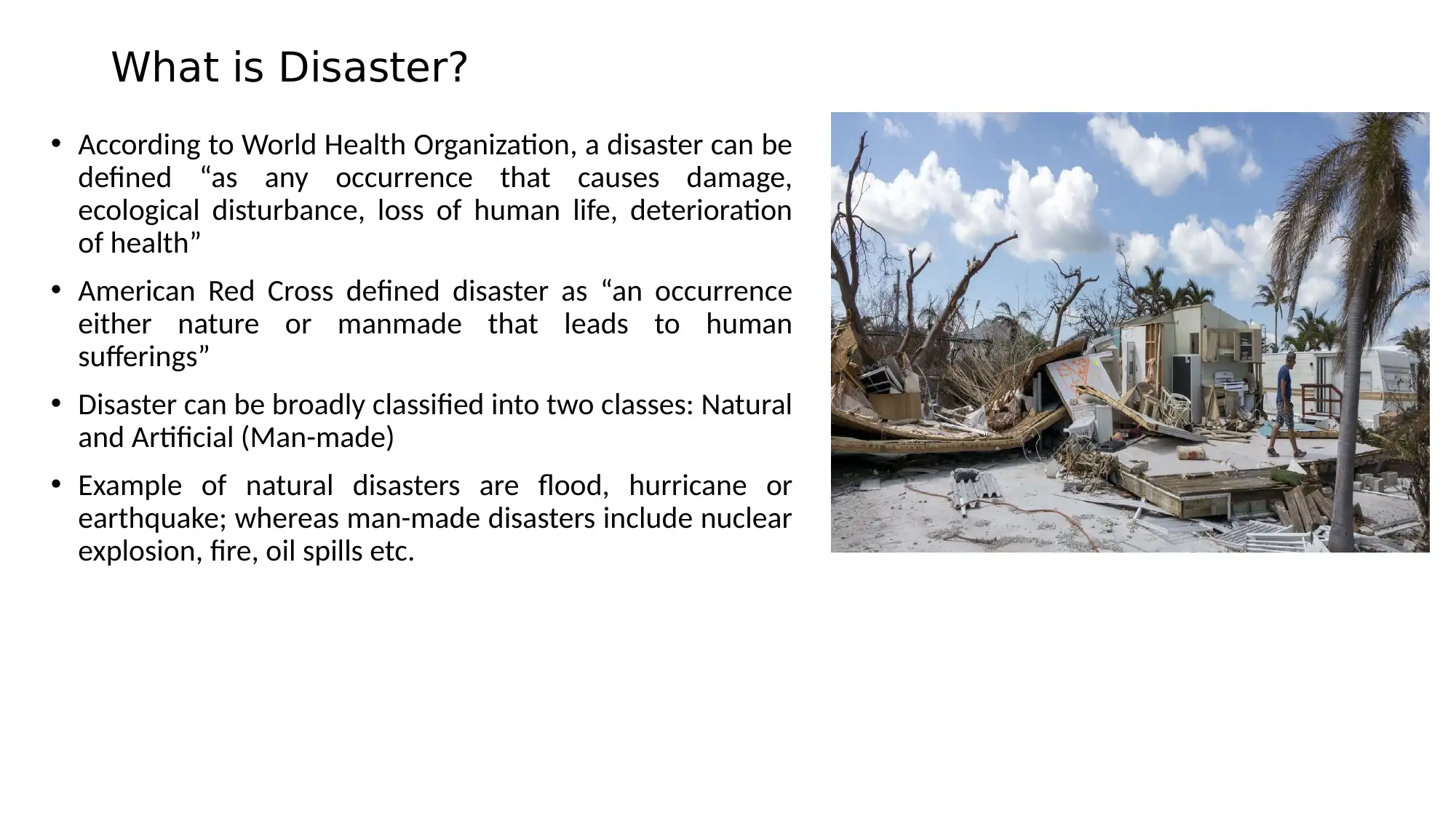
What is Disaster?
• According to World Health Organization, a disaster can be
defined “as any occurrence that causes damage,
ecological disturbance, loss of human life, deterioration
of health”
• American Red Cross defined disaster as “an occurrence
either nature or manmade that leads to human
sufferings”
• Disaster can be broadly classified into two classes: Natural
and Artificial (Man-made)
• Example of natural disasters are flood, hurricane or
earthquake; whereas man-made disasters include nuclear
explosion, fire, oil spills etc.
• According to World Health Organization, a disaster can be
defined “as any occurrence that causes damage,
ecological disturbance, loss of human life, deterioration
of health”
• American Red Cross defined disaster as “an occurrence
either nature or manmade that leads to human
sufferings”
• Disaster can be broadly classified into two classes: Natural
and Artificial (Man-made)
• Example of natural disasters are flood, hurricane or
earthquake; whereas man-made disasters include nuclear
explosion, fire, oil spills etc.
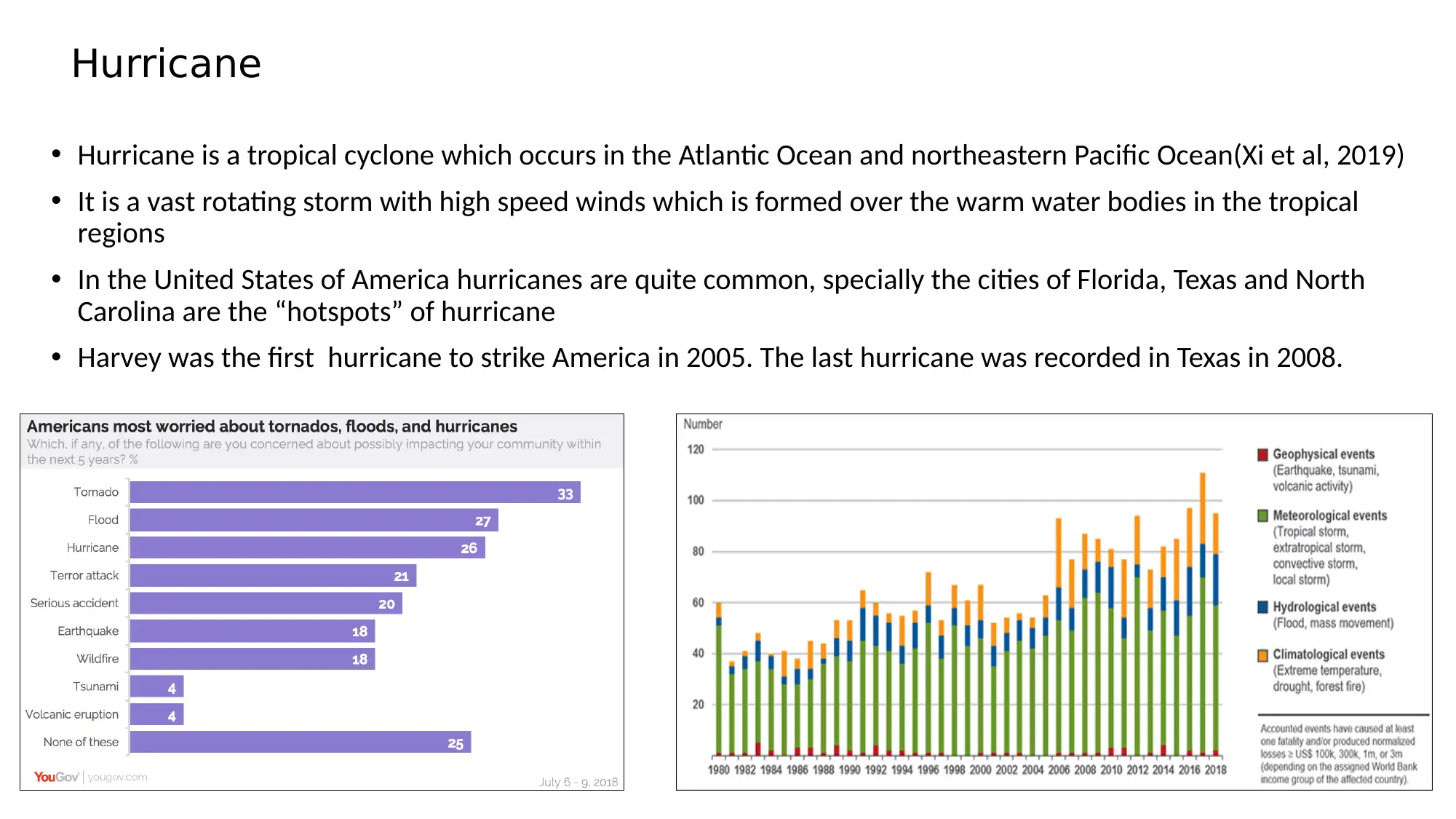
Hurricane
• Hurricane is a tropical cyclone which occurs in the Atlantic Ocean and northeastern Pacific Ocean(Xi et al, 2019)
• It is a vast rotating storm with high speed winds which is formed over the warm water bodies in the tropical
regions
• In the United States of America hurricanes are quite common, specially the cities of Florida, Texas and North
Carolina are the “hotspots” of hurricane
• Harvey was the first hurricane to strike America in 2005. The last hurricane was recorded in Texas in 2008.
• Hurricane is a tropical cyclone which occurs in the Atlantic Ocean and northeastern Pacific Ocean(Xi et al, 2019)
• It is a vast rotating storm with high speed winds which is formed over the warm water bodies in the tropical
regions
• In the United States of America hurricanes are quite common, specially the cities of Florida, Texas and North
Carolina are the “hotspots” of hurricane
• Harvey was the first hurricane to strike America in 2005. The last hurricane was recorded in Texas in 2008.
⊘ This is a preview!⊘
Do you want full access?
Subscribe today to unlock all pages.

Trusted by 1+ million students worldwide
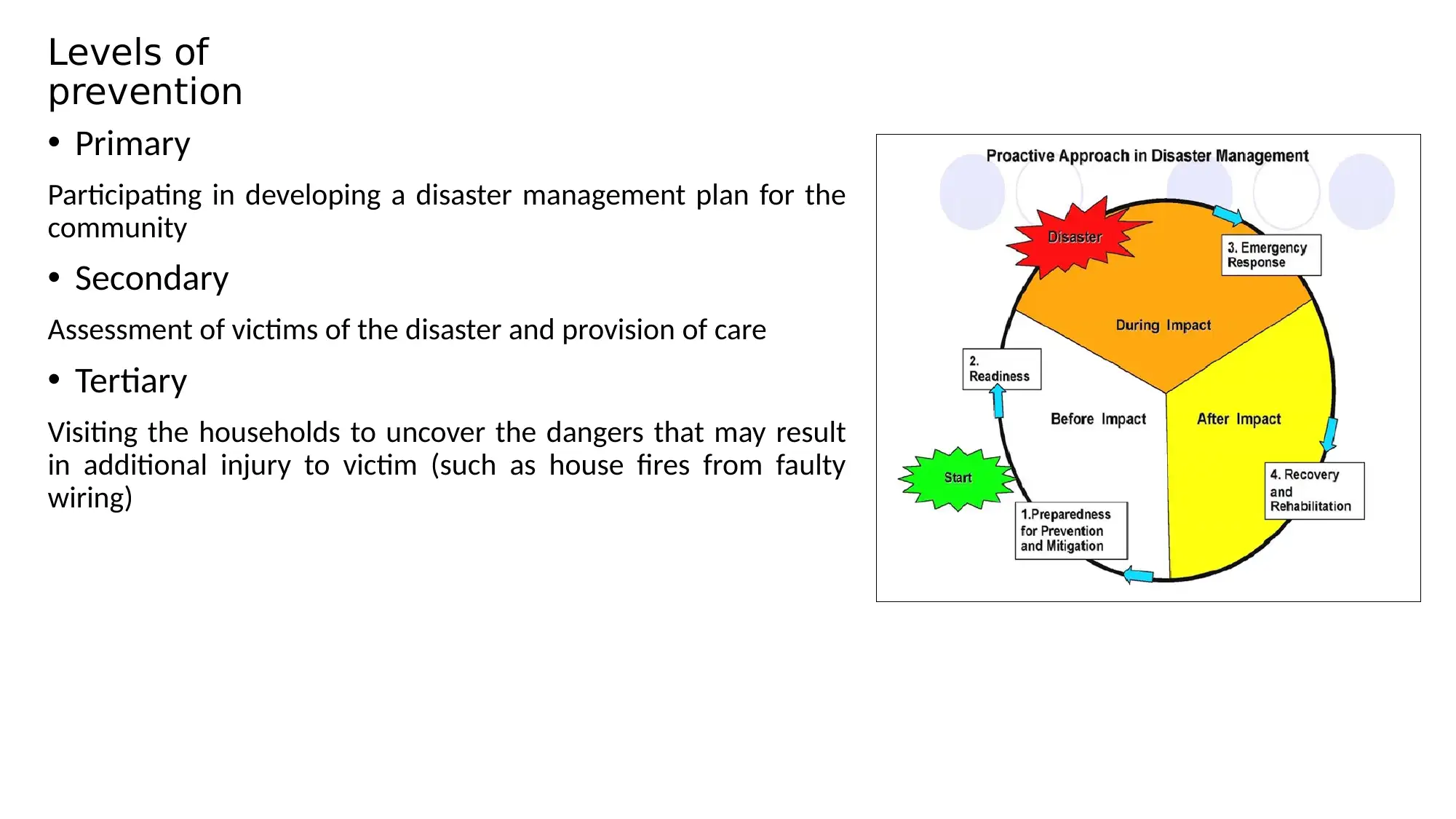
Levels of
prevention
• Primary
Participating in developing a disaster management plan for the
community
• Secondary
Assessment of victims of the disaster and provision of care
• Tertiary
Visiting the households to uncover the dangers that may result
in additional injury to victim (such as house fires from faulty
wiring)
prevention
• Primary
Participating in developing a disaster management plan for the
community
• Secondary
Assessment of victims of the disaster and provision of care
• Tertiary
Visiting the households to uncover the dangers that may result
in additional injury to victim (such as house fires from faulty
wiring)
Paraphrase This Document
Need a fresh take? Get an instant paraphrase of this document with our AI Paraphraser
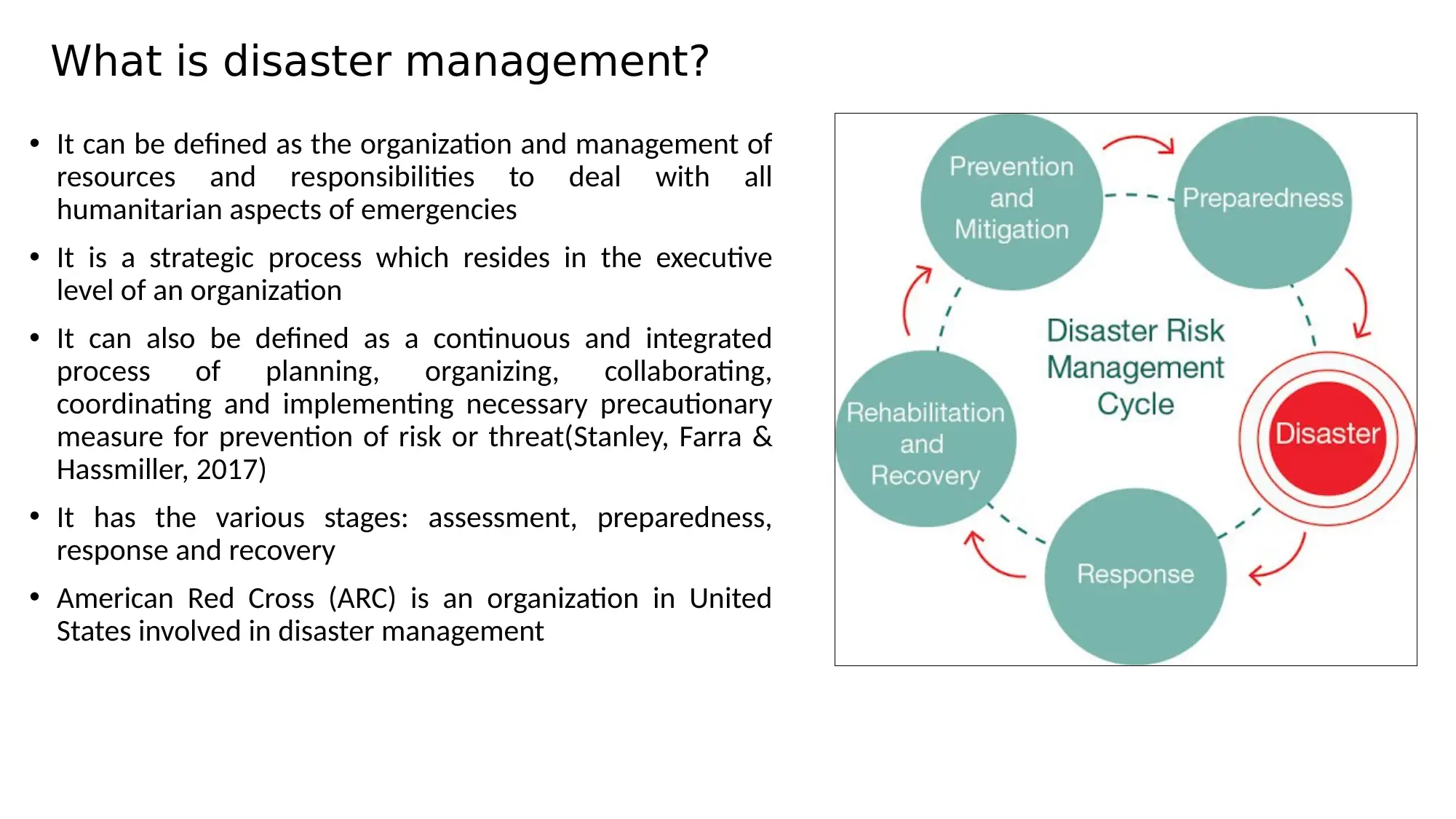
What is disaster management?
• It can be defined as the organization and management of
resources and responsibilities to deal with all
humanitarian aspects of emergencies
• It is a strategic process which resides in the executive
level of an organization
• It can also be defined as a continuous and integrated
process of planning, organizing, collaborating,
coordinating and implementing necessary precautionary
measure for prevention of risk or threat(Stanley, Farra &
Hassmiller, 2017)
• It has the various stages: assessment, preparedness,
response and recovery
• American Red Cross (ARC) is an organization in United
States involved in disaster management
• It can be defined as the organization and management of
resources and responsibilities to deal with all
humanitarian aspects of emergencies
• It is a strategic process which resides in the executive
level of an organization
• It can also be defined as a continuous and integrated
process of planning, organizing, collaborating,
coordinating and implementing necessary precautionary
measure for prevention of risk or threat(Stanley, Farra &
Hassmiller, 2017)
• It has the various stages: assessment, preparedness,
response and recovery
• American Red Cross (ARC) is an organization in United
States involved in disaster management
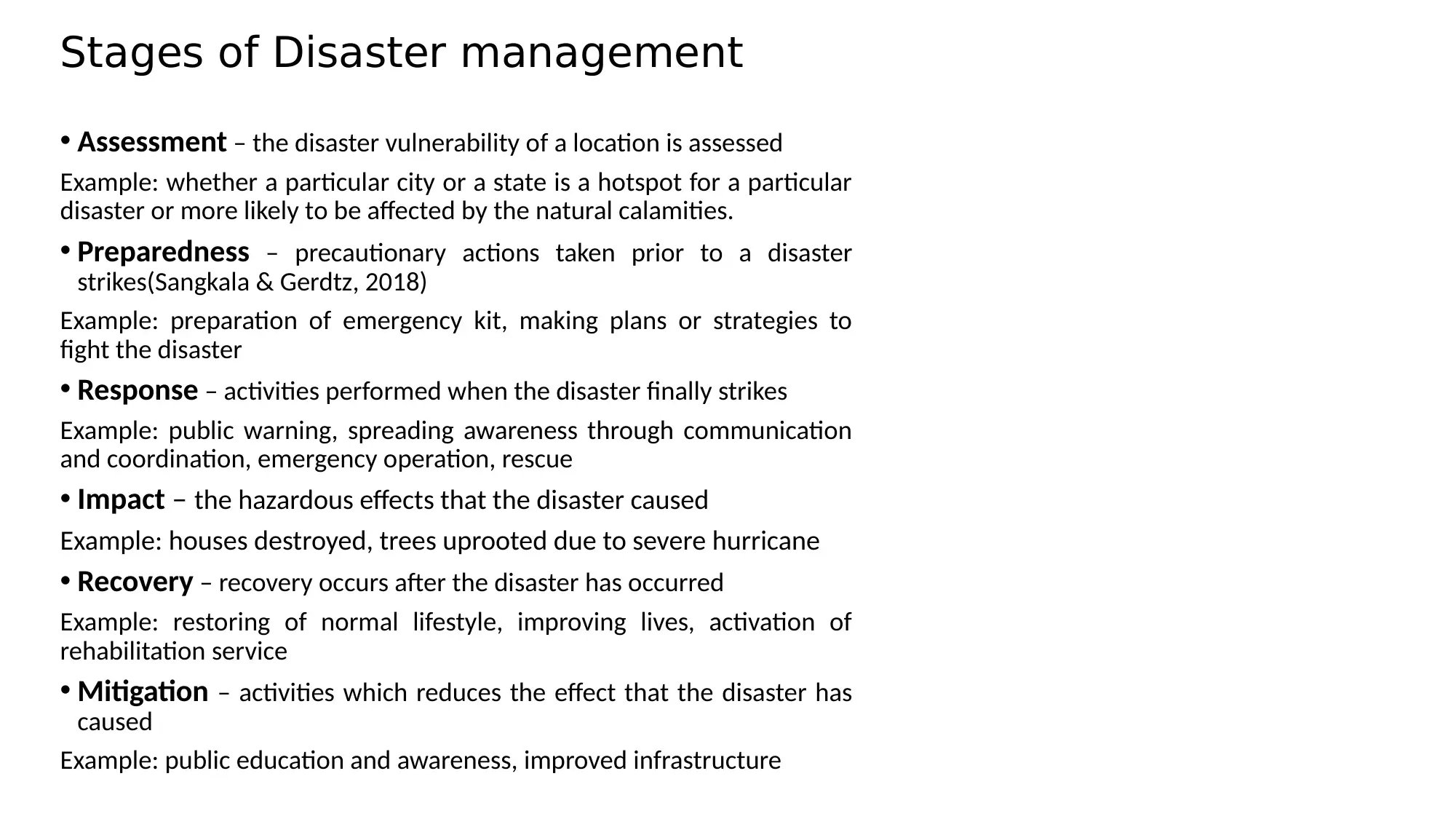
Stages of Disaster management
• Assessment – the disaster vulnerability of a location is assessed
Example: whether a particular city or a state is a hotspot for a particular
disaster or more likely to be affected by the natural calamities.
• Preparedness – precautionary actions taken prior to a disaster
strikes(Sangkala & Gerdtz, 2018)
Example: preparation of emergency kit, making plans or strategies to
fight the disaster
• Response – activities performed when the disaster finally strikes
Example: public warning, spreading awareness through communication
and coordination, emergency operation, rescue
• Impact – the hazardous effects that the disaster caused
Example: houses destroyed, trees uprooted due to severe hurricane
• Recovery – recovery occurs after the disaster has occurred
Example: restoring of normal lifestyle, improving lives, activation of
rehabilitation service
• Mitigation – activities which reduces the effect that the disaster has
caused
Example: public education and awareness, improved infrastructure
• Assessment – the disaster vulnerability of a location is assessed
Example: whether a particular city or a state is a hotspot for a particular
disaster or more likely to be affected by the natural calamities.
• Preparedness – precautionary actions taken prior to a disaster
strikes(Sangkala & Gerdtz, 2018)
Example: preparation of emergency kit, making plans or strategies to
fight the disaster
• Response – activities performed when the disaster finally strikes
Example: public warning, spreading awareness through communication
and coordination, emergency operation, rescue
• Impact – the hazardous effects that the disaster caused
Example: houses destroyed, trees uprooted due to severe hurricane
• Recovery – recovery occurs after the disaster has occurred
Example: restoring of normal lifestyle, improving lives, activation of
rehabilitation service
• Mitigation – activities which reduces the effect that the disaster has
caused
Example: public education and awareness, improved infrastructure
⊘ This is a preview!⊘
Do you want full access?
Subscribe today to unlock all pages.

Trusted by 1+ million students worldwide
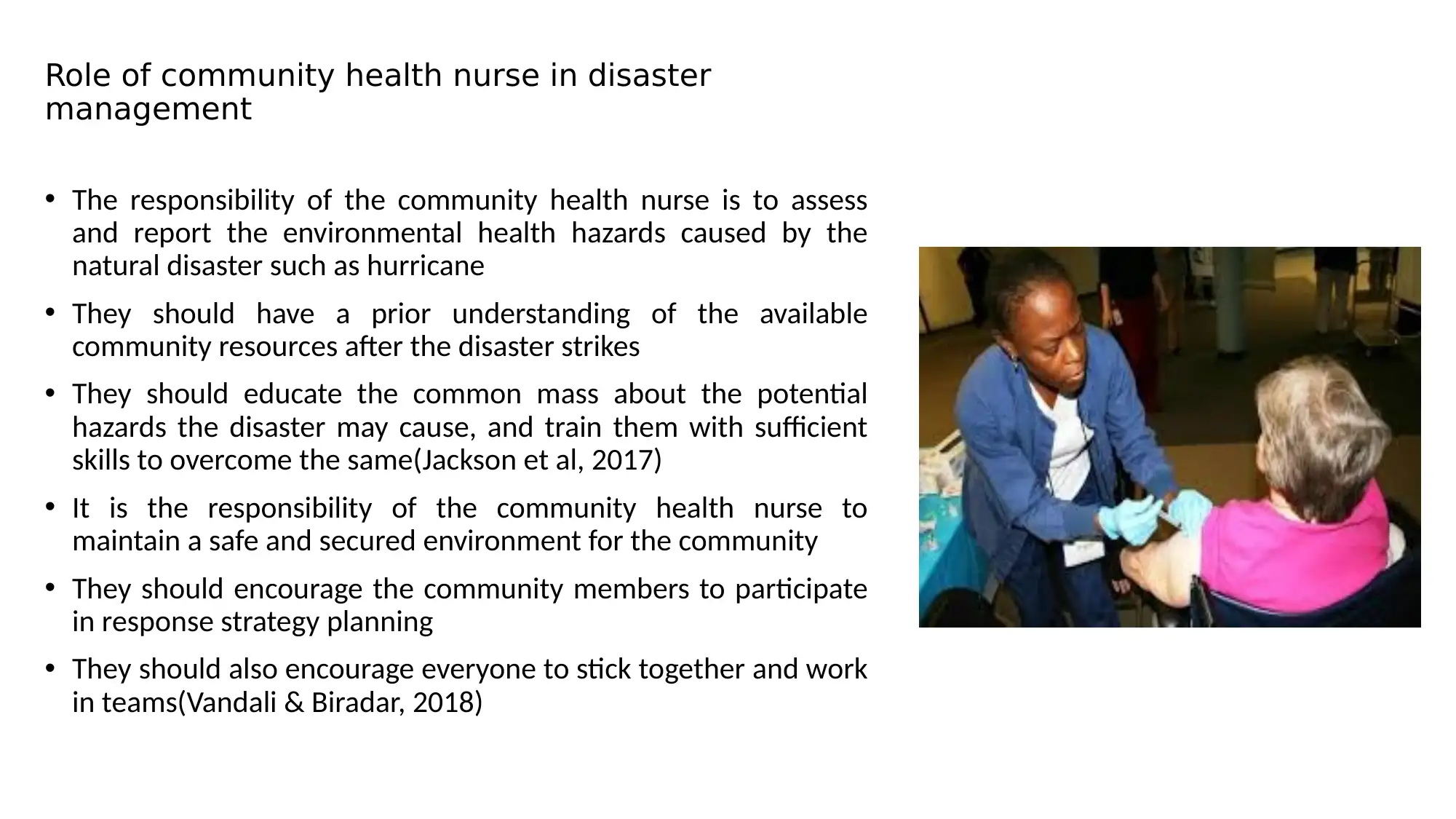
Role of community health nurse in disaster
management
• The responsibility of the community health nurse is to assess
and report the environmental health hazards caused by the
natural disaster such as hurricane
• They should have a prior understanding of the available
community resources after the disaster strikes
• They should educate the common mass about the potential
hazards the disaster may cause, and train them with sufficient
skills to overcome the same(Jackson et al, 2017)
• It is the responsibility of the community health nurse to
maintain a safe and secured environment for the community
• They should encourage the community members to participate
in response strategy planning
• They should also encourage everyone to stick together and work
in teams(Vandali & Biradar, 2018)
management
• The responsibility of the community health nurse is to assess
and report the environmental health hazards caused by the
natural disaster such as hurricane
• They should have a prior understanding of the available
community resources after the disaster strikes
• They should educate the common mass about the potential
hazards the disaster may cause, and train them with sufficient
skills to overcome the same(Jackson et al, 2017)
• It is the responsibility of the community health nurse to
maintain a safe and secured environment for the community
• They should encourage the community members to participate
in response strategy planning
• They should also encourage everyone to stick together and work
in teams(Vandali & Biradar, 2018)
Paraphrase This Document
Need a fresh take? Get an instant paraphrase of this document with our AI Paraphraser
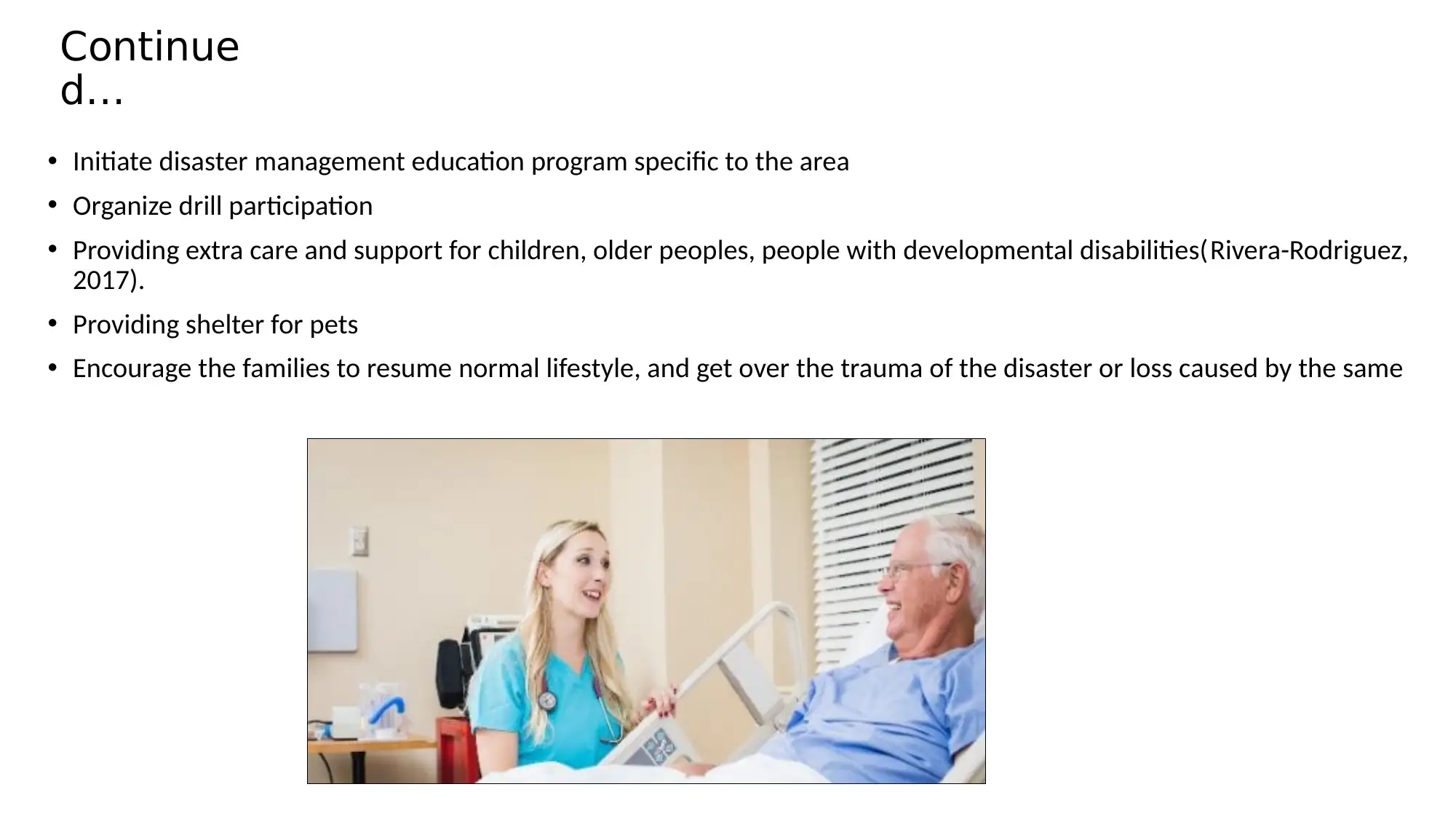
Continue
d…
• Initiate disaster management education program specific to the area
• Organize drill participation
• Providing extra care and support for children, older peoples, people with developmental disabilities(Rivera-Rodriguez,
2017).
• Providing shelter for pets
• Encourage the families to resume normal lifestyle, and get over the trauma of the disaster or loss caused by the same
d…
• Initiate disaster management education program specific to the area
• Organize drill participation
• Providing extra care and support for children, older peoples, people with developmental disabilities(Rivera-Rodriguez,
2017).
• Providing shelter for pets
• Encourage the families to resume normal lifestyle, and get over the trauma of the disaster or loss caused by the same
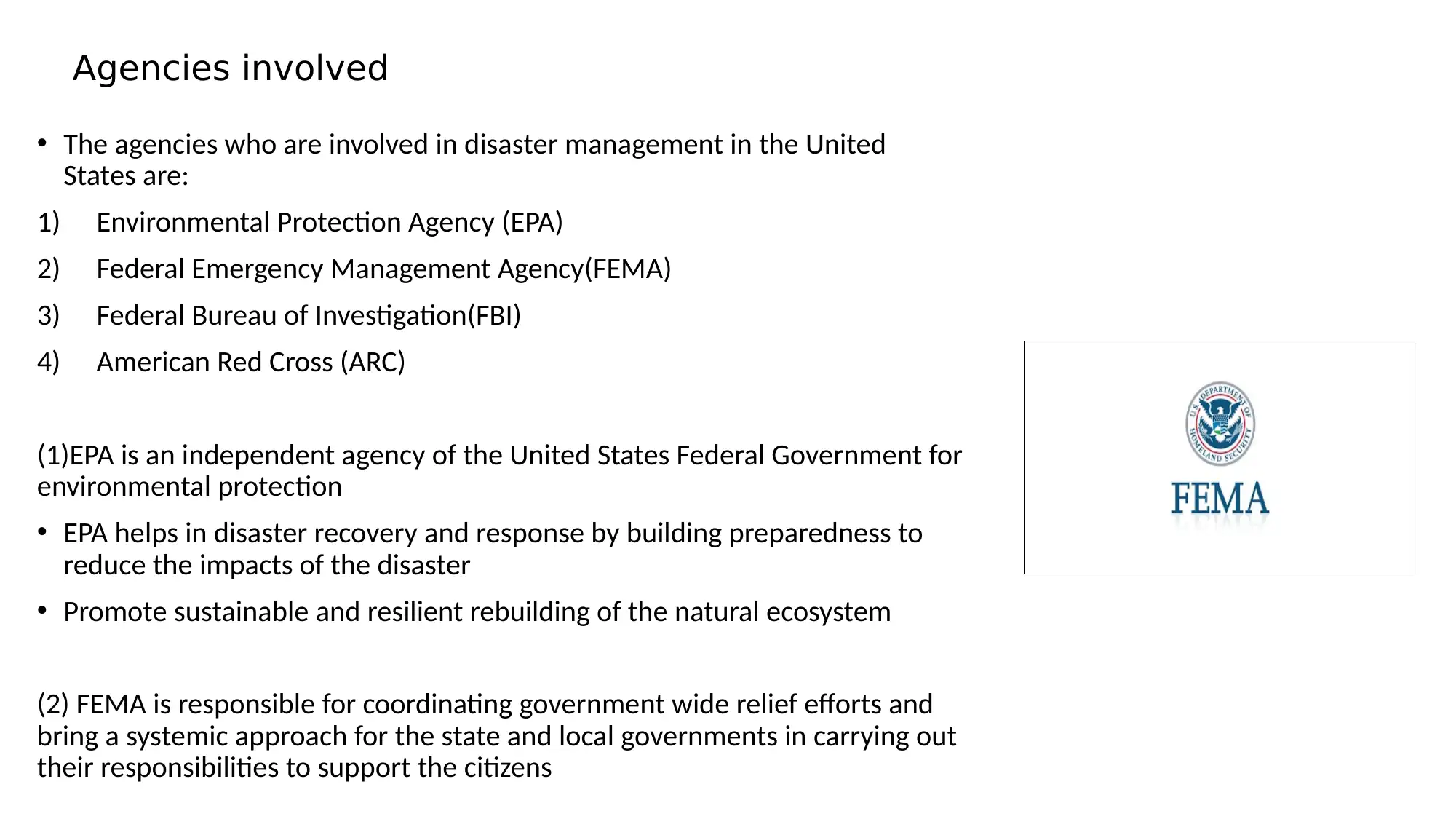
Agencies involved
• The agencies who are involved in disaster management in the United
States are:
1) Environmental Protection Agency (EPA)
2) Federal Emergency Management Agency(FEMA)
3) Federal Bureau of Investigation(FBI)
4) American Red Cross (ARC)
(1)EPA is an independent agency of the United States Federal Government for
environmental protection
• EPA helps in disaster recovery and response by building preparedness to
reduce the impacts of the disaster
• Promote sustainable and resilient rebuilding of the natural ecosystem
(2) FEMA is responsible for coordinating government wide relief efforts and
bring a systemic approach for the state and local governments in carrying out
their responsibilities to support the citizens
• The agencies who are involved in disaster management in the United
States are:
1) Environmental Protection Agency (EPA)
2) Federal Emergency Management Agency(FEMA)
3) Federal Bureau of Investigation(FBI)
4) American Red Cross (ARC)
(1)EPA is an independent agency of the United States Federal Government for
environmental protection
• EPA helps in disaster recovery and response by building preparedness to
reduce the impacts of the disaster
• Promote sustainable and resilient rebuilding of the natural ecosystem
(2) FEMA is responsible for coordinating government wide relief efforts and
bring a systemic approach for the state and local governments in carrying out
their responsibilities to support the citizens
⊘ This is a preview!⊘
Do you want full access?
Subscribe today to unlock all pages.

Trusted by 1+ million students worldwide
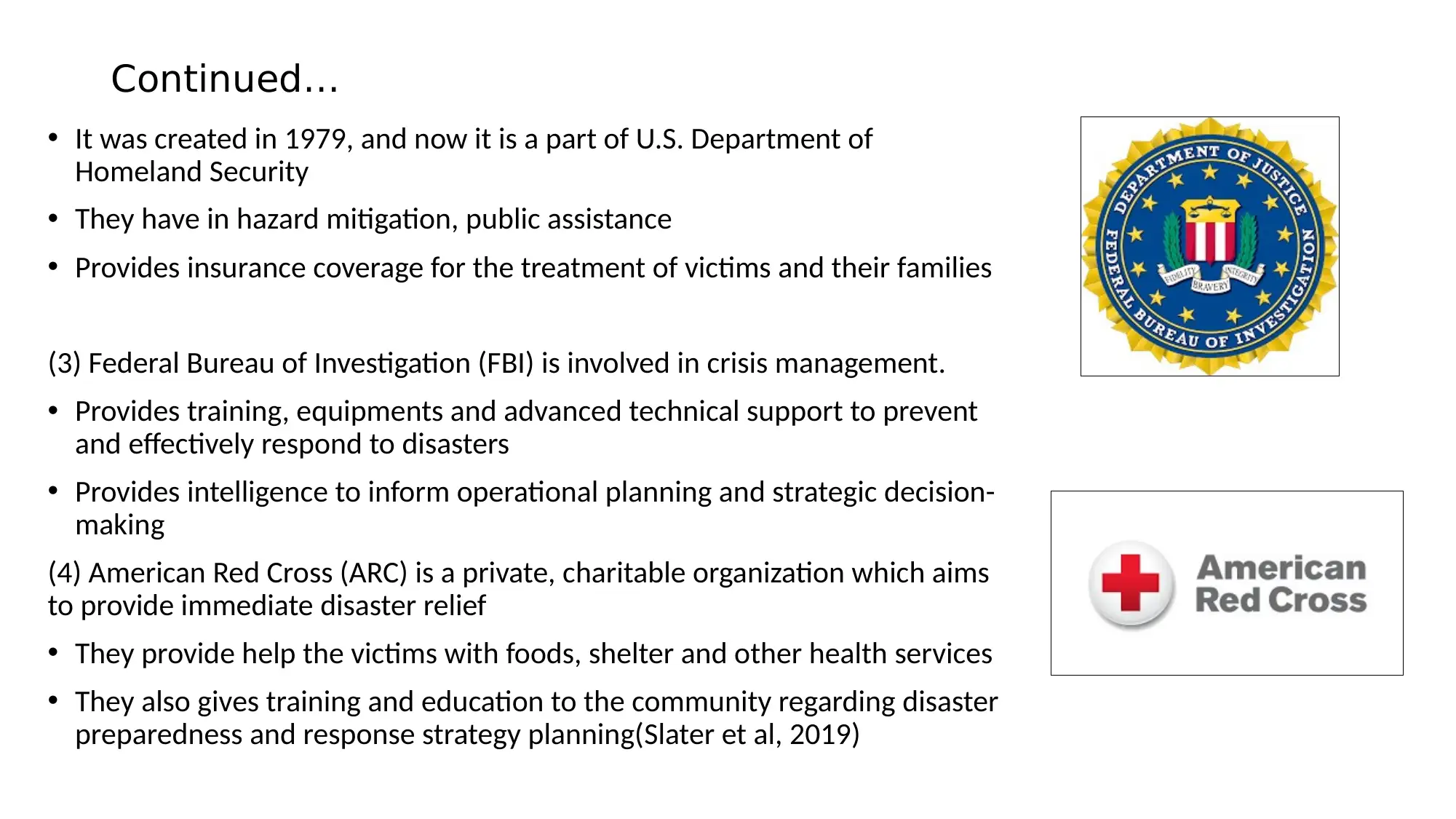
Continued…
• It was created in 1979, and now it is a part of U.S. Department of
Homeland Security
• They have in hazard mitigation, public assistance
• Provides insurance coverage for the treatment of victims and their families
(3) Federal Bureau of Investigation (FBI) is involved in crisis management.
• Provides training, equipments and advanced technical support to prevent
and effectively respond to disasters
• Provides intelligence to inform operational planning and strategic decision-
making
(4) American Red Cross (ARC) is a private, charitable organization which aims
to provide immediate disaster relief
• They provide help the victims with foods, shelter and other health services
• They also gives training and education to the community regarding disaster
preparedness and response strategy planning(Slater et al, 2019)
• It was created in 1979, and now it is a part of U.S. Department of
Homeland Security
• They have in hazard mitigation, public assistance
• Provides insurance coverage for the treatment of victims and their families
(3) Federal Bureau of Investigation (FBI) is involved in crisis management.
• Provides training, equipments and advanced technical support to prevent
and effectively respond to disasters
• Provides intelligence to inform operational planning and strategic decision-
making
(4) American Red Cross (ARC) is a private, charitable organization which aims
to provide immediate disaster relief
• They provide help the victims with foods, shelter and other health services
• They also gives training and education to the community regarding disaster
preparedness and response strategy planning(Slater et al, 2019)
Paraphrase This Document
Need a fresh take? Get an instant paraphrase of this document with our AI Paraphraser
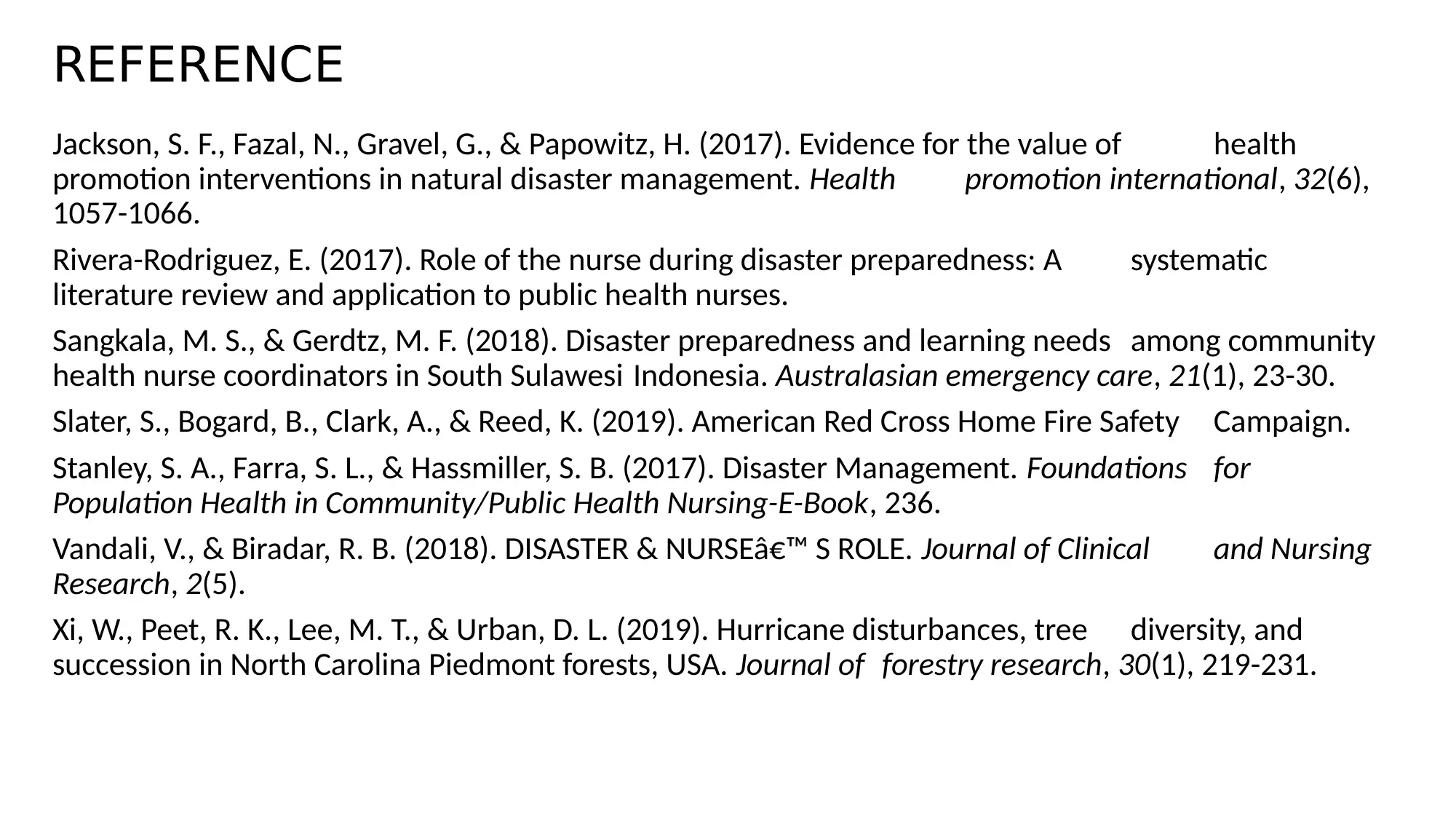
REFERENCE
Jackson, S. F., Fazal, N., Gravel, G., & Papowitz, H. (2017). Evidence for the value of health
promotion interventions in natural disaster management. Health promotion international, 32(6),
1057-1066.
Rivera-Rodriguez, E. (2017). Role of the nurse during disaster preparedness: A systematic
literature review and application to public health nurses.
Sangkala, M. S., & Gerdtz, M. F. (2018). Disaster preparedness and learning needs among community
health nurse coordinators in South Sulawesi Indonesia. Australasian emergency care, 21(1), 23-30.
Slater, S., Bogard, B., Clark, A., & Reed, K. (2019). American Red Cross Home Fire Safety Campaign.
Stanley, S. A., Farra, S. L., & Hassmiller, S. B. (2017). Disaster Management. Foundations for
Population Health in Community/Public Health Nursing-E-Book, 236.
Vandali, V., & Biradar, R. B. (2018). DISASTER & NURSE’ S ROLE. Journal of Clinical and Nursing
Research, 2(5).
Xi, W., Peet, R. K., Lee, M. T., & Urban, D. L. (2019). Hurricane disturbances, tree diversity, and
succession in North Carolina Piedmont forests, USA. Journal of forestry research, 30(1), 219-231.
Jackson, S. F., Fazal, N., Gravel, G., & Papowitz, H. (2017). Evidence for the value of health
promotion interventions in natural disaster management. Health promotion international, 32(6),
1057-1066.
Rivera-Rodriguez, E. (2017). Role of the nurse during disaster preparedness: A systematic
literature review and application to public health nurses.
Sangkala, M. S., & Gerdtz, M. F. (2018). Disaster preparedness and learning needs among community
health nurse coordinators in South Sulawesi Indonesia. Australasian emergency care, 21(1), 23-30.
Slater, S., Bogard, B., Clark, A., & Reed, K. (2019). American Red Cross Home Fire Safety Campaign.
Stanley, S. A., Farra, S. L., & Hassmiller, S. B. (2017). Disaster Management. Foundations for
Population Health in Community/Public Health Nursing-E-Book, 236.
Vandali, V., & Biradar, R. B. (2018). DISASTER & NURSE’ S ROLE. Journal of Clinical and Nursing
Research, 2(5).
Xi, W., Peet, R. K., Lee, M. T., & Urban, D. L. (2019). Hurricane disturbances, tree diversity, and
succession in North Carolina Piedmont forests, USA. Journal of forestry research, 30(1), 219-231.
1 out of 11
Related Documents
Your All-in-One AI-Powered Toolkit for Academic Success.
+13062052269
info@desklib.com
Available 24*7 on WhatsApp / Email
![[object Object]](/_next/static/media/star-bottom.7253800d.svg)
Unlock your academic potential
Copyright © 2020–2025 A2Z Services. All Rights Reserved. Developed and managed by ZUCOL.





